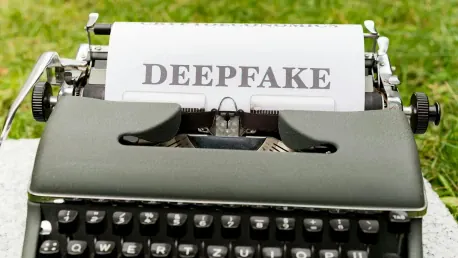Deepfake technology, which leverages artificial intelligence to create highly realistic digital replicas of real people, is advancing at an unprecedented pace. While this technology holds significant potential for innovation in various fields, it also introduces critical risks that demand urgent regulatory scrutiny. The challenge lies in striking a balance between harnessing the benefits of deepfakes and mitigating their potential for harm. This article delves into the complex issues posed by deepfakes and explores the potential regulatory solutions being considered on a global scale.
The Rising Threat of Deepfakes
Deepfakes have emerged as a major technological concern due to their capacity to deceive and manipulate. These AI-generated simulations can replicate not only the visual but also the vocal characteristics of real individuals, making it increasingly difficult to differentiate authentic content from fabricated material. The ability to create such convincing replicas presents numerous risks, ranging from financial fraud to political disinformation. In New Zealand, the threat of financial fraud through deepfakes has already been recognized, underscoring the urgency for effective regulation to counteract these malicious activities.
The potential for deepfakes to contribute to political disinformation is particularly alarming. By creating false appearances of public figures, deepfakes can spread fake news and misinformation, potentially influencing public opinion and undermining democratic processes. Furthermore, the misuse of deepfake technology extends to the creation and distribution of unauthorized pornography, including disturbing instances of child sexual abuse material. These grave concerns illustrate the pressing need for comprehensive regulatory measures to address the multifaceted threats posed by deepfakes.
Impact on Performers and Employment
The entertainment industry stands particularly vulnerable to the rise of deepfake technology, as it directly affects professional performers and entertainers. Deepfakes can be utilized to create digital replicas of actors, musicians, and other artists, thereby compromising their ability to control and monetize their images and voices. This not only jeopardizes their professional livelihoods but also poses ethical questions regarding the unauthorized use of their likenesses. The potential for deepfakes to replace human performers with digital counterparts could lead to a significant reduction in employment opportunities within the industry, fundamentally altering its landscape.
The implications extend beyond individual performers, impacting the broader entertainment ecosystem. Studios and production companies could exploit deepfakes to cut costs by reducing the reliance on human actors, thereby destabilizing the traditional dynamics of the industry. This shift necessitates the implementation of protective measures to ensure that performers retain control over their images and voices, safeguarding their economic interests and artistic integrity. The rise of deepfakes presents a unique challenge to the entertainment sector, calling for innovative solutions to preserve the rights and livelihoods of artists.
Potential Legal and Regulatory Solutions
One proposed solution to the deepfake dilemma is granting individuals Intellectual Property (IP) rights over their likenesses, thereby empowering them to enforce control over the use of their images and voices. This approach aims to address the unauthorized exploitation of deepfake technology by providing victims with legal recourse against creators and disseminators of such content. In the United States, the “No Fakes Bill” is currently under debate, which seeks to establish a new federal IP right specifically tailored to deepfake victims. This legislation could serve as a crucial model for other countries, including New Zealand, in devising regulatory frameworks to combat the misuse of deepfakes.
The No Fakes Bill proposes that individuals should be able to seek damages and injunctions against those who create or distribute deepfakes that unlawfully use their likenesses. Additionally, the bill includes provisions to safeguard the principle of freedom of expression, ensuring that commentary, criticism, scholarship, satire, and parody are protected. This balanced approach highlights the importance of preserving legitimate uses of deepfake technology while curbing its potential for harm. As policymakers globally consider similar measures, the No Fakes Bill offers valuable insights into structuring effective legal protections against deepfake exploitation.
Legislative Measures and Political Pressures
Policymakers in New Zealand are actively exploring legislative measures to address the complexities associated with deepfake misuse. One potential approach involves expanding the prohibitions outlined in the Harmful Digital Communications Act to encompass digital replicas, thereby providing a comprehensive legal framework to tackle deepfake-related offenses. Additionally, amendments to the Crimes Act, the Fair Trading Act, and the Electoral Act could be considered to further reinforce the legal barriers against the misuse of deepfake technology. These measures aim to create a robust regulatory environment that deters malicious actors and provides recourse for victims.
However, the pursuit of stringent regulations must be balanced with the need to foster technological innovation and investment. There is political pressure to ensure that regulations do not stifle the growth of AI technologies, which hold substantial potential for economic and societal benefits. A 2024 cabinet paper in New Zealand emphasized the importance of avoiding overly restrictive measures that could hinder the advancement of AI. This delicate balance necessitates carefully crafted legislation that addresses the risks of deepfakes while promoting a conducive environment for technological progress. The challenge lies in creating laws that are not only effective but also adaptable to the rapidly evolving landscape of AI.
Practical Implications of IP Rights
Under the proposed No Fakes Bill, individuals would have the ability to license their likenesses for specific purposes and durations. Licensing agreements would need to be explicit, written, and signed, with a maximum duration of ten years for living individuals. This framework aims to provide clear and enforceable guidelines for the use of individuals’ images and voices, ensuring that they retain control over their digital replicas. However, there are potential pitfalls associated with the implementation of such IP rights, which warrant careful consideration to avoid unintended consequences.
One notable concern is the ambiguous term “licensable in whole or in part,” which could lead to individuals inadvertently signing away all uses of their likenesses. This ambiguity highlights the need for precise and unambiguous language in licensing agreements to prevent exploitation. Furthermore, the bill does not adequately address reputational protections, leaving individuals vulnerable to unsanctioned uses that could tarnish their dignity and professional standing. These shortcomings underscore the importance of comprehensive and well-defined legal frameworks that safeguard individuals’ interests while promoting ethical use of deepfake technology.
Enforcement Mechanisms and Global Impacts
The No Fakes Bill includes provisions to hold internet service providers (ISPs) accountable for removing infringing material swiftly upon notification, thereby protecting them from liability. However, the bill lacks mechanisms for individuals to demand ISPs block access to sites from foreign jurisdictions, which poses significant challenges for victims whose likenesses are exploited on international platforms. Site-blocking orders, commonly used in various countries, can offer practical relief for individuals affected by deepfakes circulating on global websites. The absence of such mechanisms in the U.S. and New Zealand highlights the need for stronger enforcement measures to address the transnational nature of deepfake misuse.
Effective enforcement requires a collaborative approach involving international cooperation and standardized regulations. The global reach of the internet necessitates coordinated efforts to tackle deepfake-related offenses and ensure that victims can seek redress regardless of jurisdictional boundaries. Robust enforcement mechanisms, including site-blocking orders and international agreements, are essential to provide comprehensive protection against the proliferation of deepfakes. As policymakers consider the implementation of such measures, it is crucial to address the complexities of cross-border enforcement and facilitate cooperation among nations.
Broadening the Scope of IP Protections
The No Fakes Bill aims to extend IP rights protections beyond celebrities, ensuring that “everyday” individuals are also covered. This inclusive approach allows anyone readily identifiable in a deepfake to seek legal recourse, thereby broadening the scope of protections and addressing the diverse range of victims affected by deepfake misuse. However, concerns remain about the high threshold required to qualify for these protections, which could limit the bill’s effectiveness. The ambiguity surrounding what constitutes “readily identifiable” poses challenges for ordinary individuals who might only be recognized by their immediate circles.
To address these concerns, the legislation must provide clear and accessible criteria for qualifying for IP protections, ensuring that all individuals have the opportunity to seek redress for unauthorized use of their likenesses. This inclusive approach is essential for creating a fair and equitable legal framework that safeguards the rights of all individuals, irrespective of their public profile. By broadening the scope of IP protections, the legislation can offer meaningful relief to a wider population, promoting accountability and responsible use of deepfake technology.
Balancing Regulation and Freedom of Expression
Deepfake technology, which uses artificial intelligence to produce incredibly realistic digital likenesses of real individuals, is advancing quickly. While this technology has the potential to drive innovation in numerous sectors, it also presents significant risks that require urgent regulatory attention. The key challenge is to find a balance between maximizing the benefits of deepfakes and reducing their potential for misuse or harm. This article examines the multifaceted issues associated with deepfakes, such as misinformation, identity theft, and privacy violations. It also explores potential regulatory approaches being discussed worldwide to address these concerns. Policymakers are considering various measures, such as technological safeguards, legal frameworks, and international cooperation, to manage and control the use of deepfakes responsibly. The goal is to promote the positive applications of this technology while protecting individuals and societies from its adverse effects.









